Pembroke School Chapel
Holden Street, Kensington Park
George Stephens, Adelaide, 1989
2 manuals, 22 speaking stops, 4 couplers, mechanical action (electric stop action)
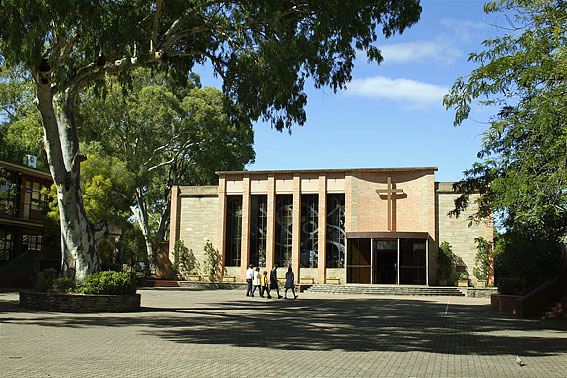
Pembroke School Chapel
[Photograph by Trevor Bunning (March 2009)]
Historical and Technical Documentation by David Shield and John Maidment
© OHTA 1991, 2009, 2019 (last updated November 2019)
Pembroke School was formed in 1974 as a result of the amalgamation of Girton Girls' School (a private school established in Kensington in 1915) and the King's School for boys (founded jointly in the early 1920s by Congregationalists and Baptists).1 Now a co-educational Uniting Church school, the school occupies the original campus of the King's School.
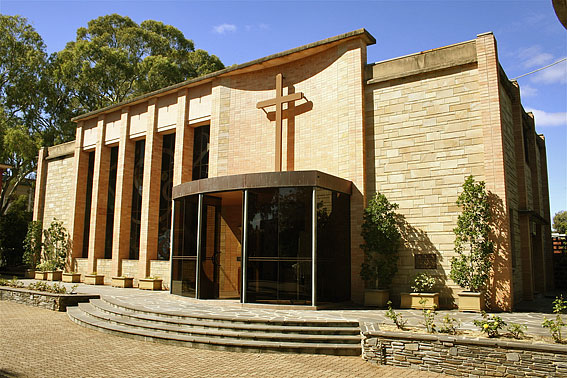
Pembroke School Chapel - exterior
[Photograph by Trevor Bunning (March 2009)]
The chapel was built in 1962 during the headmastership at the King's School of the Revd. R.A. Crook (1957–1973). At the dedication ceremony on 27 May 1962, much was made of the lighted cross, 'the light, which guided those who put their trust in Christ.'2 A prominent feature of the chapel is the stained glass windows, the work of Adelaide artist Cedar Prest OAM. The east window tells the creation story and was undertaken as an Artist in Schools project with year 11 in 1999.
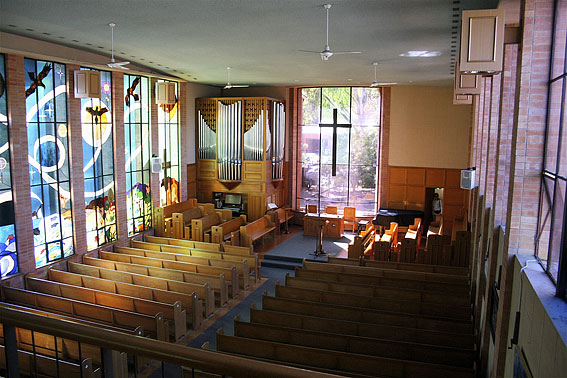
Pembroke School Chapel – interior
[Photograph by Trevor Bunning (March 2009)]
An electronic organ accompanied the singing in the chapel until replaced by the present organ in 1989. The pipe organ was built by George Stephens of Adelaide, and installed in January 1989.
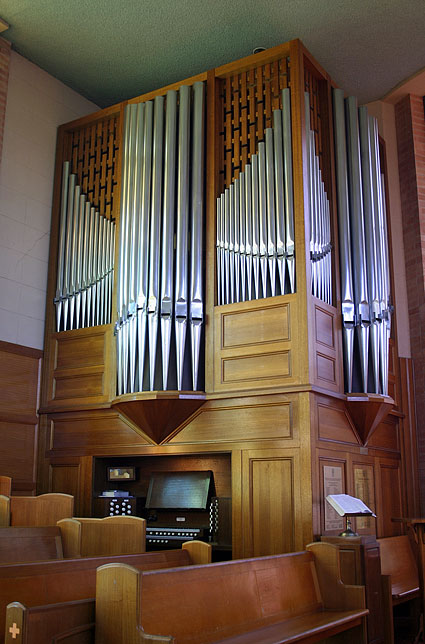
Pembroke School Chapel – organ
[Photograph by Trevor Bunning (March 2009)]
George Stephens was apprenticed originally to the English firm Rushworth and Dreaper in Liverpool. He moved to Australia in 1962, working initially with Hill, Norman & Beard (Australia) Pty Ltd, Clifton Hill, Melbourne on tonal finishing and voicing. From 1965 to 1975 he worked for Steve Laurie in Melbourne, before setting up his own company G & J Stephens with his brother John from 1975, and finally his own business George Stephens Organ Builder, Adelaide, from 1981. He purchased the remains of the Adelaide firm J.E. Dodd & Sons Gunstar Organ Works at Plympton, S.A. in 1979, and relocated the business from Plympton to Lonsdale in 1983. The company formally closed in June 2007.3
With mechanical action to the keys, tubular-pneumatic action to the offnote chests and electric stop action, the Pembroke School organ is the largest new instrument that Stephens has constructed using mechanical key action. It is notable for its solidity of construction, and the quality of the voicing. The instrument incorporates a hardwood case with burnished tin façade pipes.
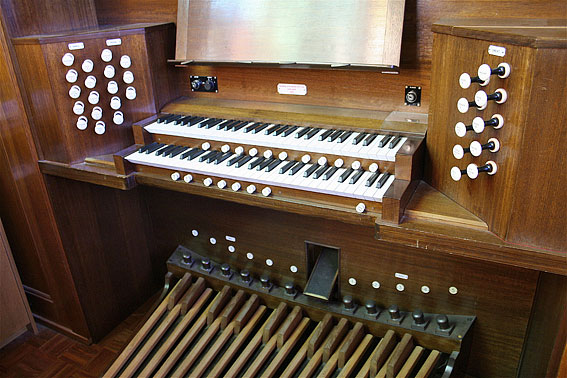
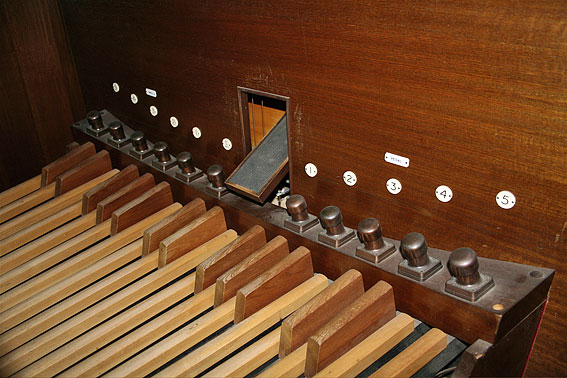
Pembroke School Chapel – organ console
[Photographs by Trevor Bunning (March 2009)]
The specification follows:
| GREAT ORGAN Open Diapason Stopped Diapason Principal Wald Flute Nazard Fifteenth Tierce Mixture Tremulant Swell to Great SWELL ORGAN Chimney Flute Salicional Vox Celeste (TC) Gemshorn Flageolet Sharp Mixture Clarinet Trumpet Oboe Tremulant PEDAL ORGAN Bourdon 16 Principal 8 Bass Flute 8 Octave 4 Trombone 16 Great to Pedal Swell to Pedal |
8 8 4 4 2-2/3 2 1-3/5 II 8 8 8 4 2 III 16 8 8 16 8 8 4 16 |
Great and Pedal Pistons Coupled
Action: mechanical key action, electric stop action
Compass 58/30
Capture combination action with 4 memory levels:
5 thumb pistons to Great
5 thumb pistons to Swell
5 general thumb pistons
5 toe pistons to Pedal
5 toe Pistons to Swell
Reversible thumb & toe pistons for Great to Pedal
Reversible thumb pistons for Swell to Great, Swell to Pedal
1 general cancel piston
1 keyswitch to secure piston combinations
1 switch to select memory level
Balanced swell pedal.4
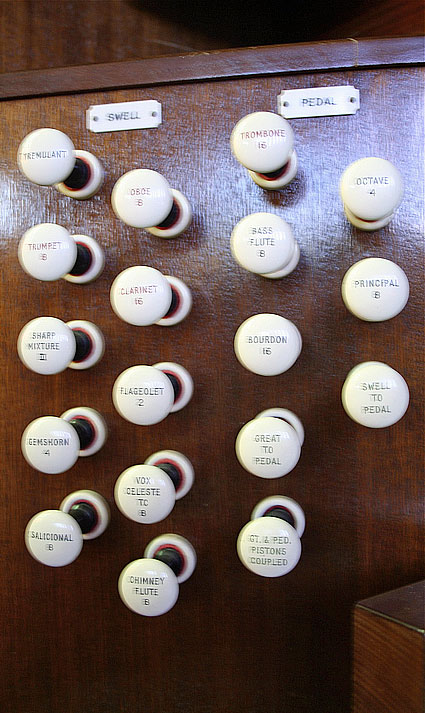
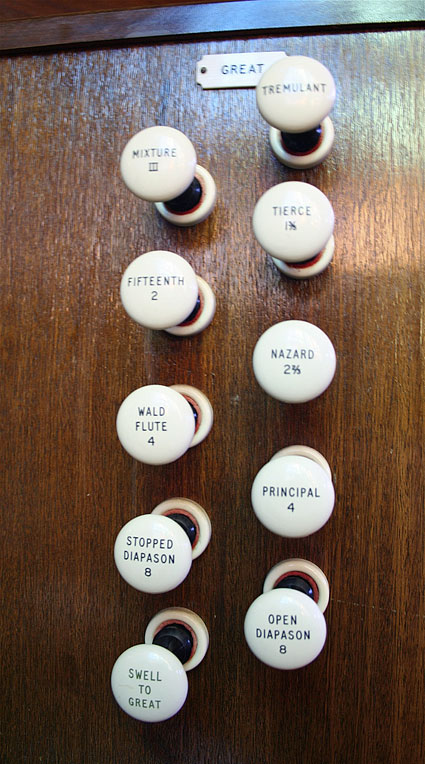
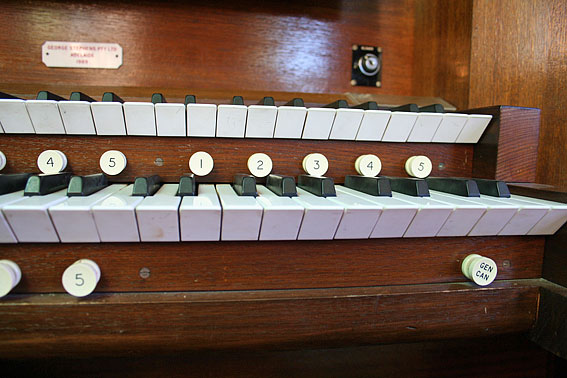
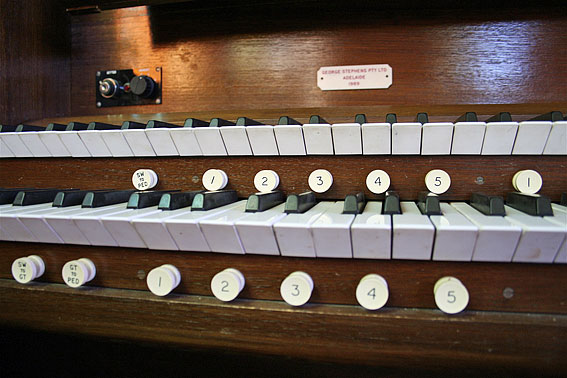
Pembroke School Chapel – organ console details
[Photographs by Trevor Bunning (March 2009)]
__________________________________________________
1 Background information on the two schools may be found in: John Robert Davis, Principles and Pragmatism: a History of Girton, King's College and Pembroke School ([Kensington Park]: Pembroke School Council, 1991), and in John Cameron, In Stows Footsteps: A Chronological History of the Congregational Churches in S.A. (Adelaide: South Australian Congregational History Project Committee, 1987).
2 Davis, op. cit.
3 [Val Stephens, Biographical Sleeve Notes] 'By George: a Tribute to the Work of George Stephens' (2-CD set, privately produced by Terry Truman, April 2008).
4 Organ Music Society of Adelaide Newsletter, vol. 22, no. 3 (June/July 1989), pp. 3-4.